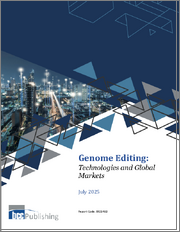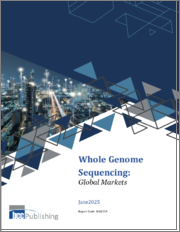
|
시장보고서
상품코드
1866184
유전자 라이팅 및 프로그래밍 가능한 유전체 공학 : 정밀 유전자 삽입, 수복 및 합성 DNA 라이팅 플랫폼 - 기술, 파이프라인 동향, 경쟁 정보 및 세계 시장 전망(2025-2045년)Gene Writing & Programmable Genome Engineering: Precision Gene Insertion, Repair & Synthetic DNA Writing Platforms - Technology, Pipeline Landscape, Competitive Intelligence & Global Market Outlook 2025-2045 |
||||||
주요 요약/개요
유전자 라이팅 기술은 유전자 편집을 넘어선 다음 진화의 도약을 상징합니다. DNA를 절단하는 편집에서 기능적인 유전정보를 유전체에 직접 기록하는 기술로 전환하는 것입니다. 절단을 도입하는 CRISPR 뉴클레아제 기반 편집과 달리, 유전자 교정 플랫폼은 프로그램 가능한 효소, 레트로 트랜스포존, 중합효소 및 주형 유도형 DNA 합성을 이용하여 이중 가닥 절단 없이 안전하고 방향성 있게 DNA를 삽입, 치환, 재라이팅할 수 있습니다.
유전자 라이팅이 변화를 가져오는 이유 - 기존 패러다임과 차세대 패러다임의 비교
- CRISPR에 의한 절단 vs. 프로그램 가능한 DNA 코드 쓰기
- 이중 사슬 절단 수복에 의존 vs. 절단 없이 정밀하게 재라이팅하기
- 단일 유전자 복구 vs. 경로 재기술 + 새로운 생물학 설계
- 암 위험에 대한 우려 vs. Low-indel, low-off 타겟 전략
- 단회 투여 vs. 프로그램된 반복적 재라이팅
유전자 재라이팅 기술은 유전성 및 후천성 유전 질환의 진정한 근본적인 제어, 후천성 유전 질환의 근본적인 제어, 후성유전체 회춘, 체세포 조직 프로그래밍, 새로운 생물학적 기능(바이러스 저항성, 대사 회로 재구성, 장기 복구)의 실현을 가능하게 합니다.
핵심 유전자 변형 전략
- 템플릿 기반 유전체 삽입
- RNA 가이드형 유전자 라이팅 기술
- 역전사효소(RT)에 의한 유전자 통합
- 재조합 효소 및 인테그라제 설계
- 프로그램 가능한 중합효소 시스템
- CRISPR이 없는 쓰기 회로
- 표적 유전체 영역 치환
- 염기 역전 RNA 편집 → 최종 DNA 임베디드 과정
새로운 기능에는 다음이 포함됩니다.
- 원위 유전자 위치에서의 현장 유전자 치환
- 다중 킬로바이트 삽입
- 다중 기록
- 전사 재프로그래밍을 통한 후성유전적 재설정
- 시간적 제어 (약물 유도형, 조직 특이적 기록)
시장 전망
유전자 라이팅 시장은 초기 단계(2024년) 약 8억 달러 규모에서 2035년까지 200억-400억 달러 이상, 2045년까지 1,000억 달러 이상으로 확대될 것으로 예측됩니다.
초기 상용화 시기
- 유전성 질환 치료 : 2028-2035년
- 체외에서 설계된 세포치료제: 2027-2032년
- 체내 대사 치료 : 2030-2038년
- 기능 강화/질병 예방 : 2033-2045년
- 노화 반전과 조직 회춘: 2035-2050년
과학 기술 정세
유전자 라이터 메커니즘 분류 - 카테고리, 작용기전, 주요 혁신가
- RNA-guided DNA writers - guide RNA + RT + integrase - Tessera, Tome
- Prime editing 2.0 / twinPE - pegRNA + Cas9 nickase + RT - Prime Medicine, Beam
- Programmable Integrases - serine recombinases, Bxb1, φC31 engineered libraries - Synthego, academic consortia
- Programmable Polymerases - DNA polymerase tethering - Emerging / stealth
- Transposase-based writers - piggyBac variants, Sleeping Beauty 3.0, HELIX - Poseida, Tome, Intellia-adjacent efforts
- Retrotransposon-derived circuitry - Targeted LINE-like systems - Tessera, research labs
- RNA-to-DNA rewrite - ADAR -> DNA conversion (future stack) - Academic R&D
주요 혁신 기술
- 단절 없는 삽입
- 화물 길이 확장 (1-20kb+)
- 대규모 유전자 교체 - 단순 복구가 아님
- 다중 재라이팅
- 프로그래밍 가능한 통합 부위
- 약물 제어형 조직 특이적 기록
- 면역 침묵 전달 시스템
배송 플랫폼
- LNPs(간, 근육, 중추신경계용 개발 중)
- AAV 프리 고분자 나노입자
- 인테그라제 탑재 지질소포체
- 엑소좀을 통한 전달
- 하이브리드형(바이러스성+비바이러스성) 접근법
안전에 대한 우선순위
- 오프 타겟 삽입 최소화
- 후성유전학적 부위 선택 및 매핑
- 온/오프 유전자 킬 스위치 회로
- 면역원성 억제
목차
제1장 서론
제2장 유전자 라이팅 분자생물학
- DNA 복구 및 복제 기전
- 역전사 시스템 및 통합 특이성
- 인테그라제 및 재조합효소 논리
- 유전자좌 선택을 위한 가이드-RNA 공학
- 중합효소 고정 및 템플릿 제어
- 게놈 기록의 후생유전학적 함의
제3장 유전자 라이팅 모달리티 클래스
- RNA-guided DNA writers
- Prime writing & twinPE
- Programmable integrases & recombinases
- Transposase-engineering platforms
- Polymerase-anchored writing systems
- Synthetic chromosome / portable locus tech
- Hybrid RNA->DNA relay circuits
제4장 전달 에코시스템
- LNP 진화 - 라이터 페이로드 최적화
- AAV vs. 비바이러스 vs. 하이브리드 접근
- 조직 특이적 전달 공학
- 차세대 세포 표적 펩티드
- 중추신경계, 심장 및 근육에의 전달 전략
제5장 임상 파이프라인
- 단계 및 모달리티별 프로그램
- 단기적인 임상 결과
- 질환 초점 세분화
- 유전성 질환->대사->종양학->노화
제6장 안전성과 규제 상황
- 오프 타겟 통합 어세이
- 장기적인 유전체학 모니터링 프레임워크
- 윤리적 및 환자 선택 고려사항
제7장 경쟁 정보
- 회사 상황
- 플랫폼 벤치마크
- 학술->바이오테크놀러지 파이프라인 흐름
제8장 상업 모델
- 치유적 라이팅 테라피를 위한 전략 시작
- 가격 결정(1회 한정 라이팅과 재사용 가능한 라이팅)
- 병원 및 전문센터에서의 채택
제9장 시장 예측(2025년-2045년)
- TAM/SAM/SOM
- 시나리오 모델(유지보수 목표→파괴적)
- 노화와 대사성 질환 촉매 변곡점
- ex-vivo vs. in-vivo 라이팅 시장 점유율
제10장 전략적 전망
제12장 부록
LSH 25.11.19Executive Summary / Description
Gene writing technology represents the next evolutionary leap beyond gene editing - moving from cutting DNA to writing functional genetic information directly into the genome. Unlike CRISPR nuclease-based editing which introduces breaks, gene writing platforms use programmable enzymes, retrotransposons, polymerases, and template-guided DNA synthesis to insert, replace, or rewrite DNA safely and directionally without double-strand breaks.
Why Gene Writing Is Transformational: Old Paradigm vs Next Paradigm
- CRISPR cutting vs Writing programmable DNA code
- DSB repair dependence vs Break-free precision rewriting
- Single-gene repair focus vs Rewrite pathways + engineer new biology
- Cancer-risk concern vs Low-indel, low-off-target strategies
- Single-dose vs Programmed iterative rewrites
Gene writing unlocks true curative control of inherited and acquired genetic disease, epigenomic rejuvenation, somatic tissue programming, and even new biological functions (viral resistance, metabolic rewiring, organ repair).
Core Gene Writing Strategies
- Template-based genomic insertion
- RNA-guided gene writers
- Reverse-transcriptase (RT) gene integration
- Recombinase & integrase engineering
- Programmable polymerase systems
- CRISPR-free writing circuits
- Targeted genomic locus replacement
- Base-flip RNA editing -> eventual DNA integration pipelines
Emerging capabilities include:
- In-situ gene replacement at native loci
- Multi-kb insertion
- Multiplex writing
- Epigenetic reset via transcriptional reprogramming
- Temporal control (drug-inducible, tissue-specific writing)
Market Outlook
The gene writing market is forecast to expand from ~USD 0.8B in early programs (2024) to USD 20-40B+ by 2035 and USD 100B+ by 2045.
Initial commercialization windows:
- Inherited disease cures: 2028-2035
- Ex-vivo engineered cell therapies: 2027-2032
- In-vivo metabolic cures: 2030-2038
- Functional enhancement / disease-prevention: 2033-2045
- Aging reversal and tissue rejuvenation: 2035-2050
Scientific & Technology Landscape
Mechanistic Classes of Gene Writers: Category and it's Mechanism and Leading Innovators
- RNA-guided DNA writers - guide RNA + RT + integrase - Tessera, Tome
- Prime editing 2.0 / twinPE - pegRNA + Cas9 nickase + RT - Prime Medicine, Beam
- Programmable Integrases - serine recombinases, Bxb1, φC31 engineered libraries - Synthego, academic consortia
- Programmable Polymerases - DNA polymerase tethering - Emerging / stealth
- Transposase-based writers - piggyBac variants, Sleeping Beauty 3.0, HELIX - Poseida, Tome, Intellia-adjacent efforts
- Retrotransposon-derived circuitry - Targeted LINE-like systems - Tessera, research labs
- RNA-to-DNA rewrite - ADAR -> DNA conversion (future stack) - Academic R&D
Key Innovations
- Break-free insertion
- Cargo length scaling (1-20kb+)
- Large gene replacement - not just repair
- Multiplex rewriting
- Programmable integration sites
- Drug-controlled, tissue-specific writing
- Immune-silent delivery systems
Delivery Platforms
- LNPs (liver, muscle, CNS emerging)
- AAV-free polymer nanoparticles
- Integrase-loaded lipid vesicles
- Exosome-mediated delivery
- Hybrid viral + non-viral approaches
Safety Priorities
- Off-target insertion minimization
- Epigenetic site selection & mapping
- On/off genetic kill-switch circuits
- Immunogenicity suppression
Table of Content
1. Introduction
- 1.1 Scope & objectives
- 1.2 Definition: gene writing vs gene editing vs gene therapy vs RNA editing
- 1.3 Framework for technology readiness
2. Molecular Biology of Gene Writing
- 2.1 DNA repair & replication machinery
- 2.2 RT systems & integration specificity
- 2.3 Integrase & recombinase logic
- 2.4 Guide-RNA engineering for locus selection
- 2.5 Polymerase tethering & template control
- 2.6 Epigenetic implications of genomic writing
3. Gene Writing Modality Classes
- 3.1 RNA-guided DNA writers
- 3.2 Prime writing & twinPE
- 3.3 Programmable integrases & recombinases
- 3.4 Transposase-engineering platforms
- 3.5 Polymerase-anchored writing systems
- 3.6 Synthetic chromosome / portable locus tech
- 3.7 Hybrid RNA->DNA relay circuits
4. Delivery Ecosystem
- 4.1 LNP evolution - writer payload optimization
- 4.2 AAV vs non-viral vs hybrid approaches
- 4.3 Tissue-specific delivery engineering
- 4.4 Next-gen cell-targeting peptides
- 4.5 CNS, heart & muscle delivery strategies
5. Clinical Pipeline
- 5.1 Programs by stage & modality
- 5.2 Near-term clinical readouts
- 5.3 Disease focus segmentation
- 5.4 Genetic disease -> metabolic -> oncology -> aging
6. Safety & Regulatory Landscape
- 6.1 Off-target integration assays
- 6.2 Long-term genomics monitoring frameworks
- 6.3 Ethical & patient-selection considerations
7. Competitive Intelligence
- 7.1 Company landscape
- 7.2 Platform benchmarking
- 7.3 Academic -> biotech pipeline flow
8. Commercial Model
- 8.1 Launch strategies for curative writing therapies
- 8.2 Pricing (one-time vs redosable writing)
- 8.3 Hospital & specialty-center adoption
9. Market Forecast (2025-2045)
- 9.1 TAM/SAM/SOM
- 9.2 Scenario models (conservative -> disruptive)
- 9.3 Aging & metabolic disease catalyst inflection
- 9.4 Market share of ex-vivo vs in-vivo writing
10. Strategic Outlook
- 10.1 Leading platforms & acquisition targets
- 10.2 Winning capabilities

















